I completed IRONMAN, why does it feel like a Hermes Implementation?
The Ironman Challenge, completed consecutively, without breaks, is considered one of the toughest physical challenges in the world.
- Swimming – Open water swim of 3.86 km (2.4-mile),
- Bicycle ride – 180.25 km cycle (112-mile) through, in this case, the Austrian mountains
- Running – a full 42.20 km (26.22-mile) Marathon
Professional athletes usually take 8-9 hours to complete the course, and amateurs can take up to 17 hours to reach the finish line.
I recently took part in my first Ironman competition, and during the 13:30 hours of non-stop swimming, biking and running, what was I thinking about?
Obviously, our beloved cargo industry and our Hermes software implementations.
So, what could an Ironman competition have in common with a Hermes Cargo Management System (CMS) implementation?
CMS Selection = Competition Selection
A Hermes implementation starts with the customer who selects a software provider, based on a detailed evaluation of the features, the vendor, costs etc.
In the same way, my Ironman journey started with evaluating my own ability based on completed marathons, training schedule, family commitments, costs and personal goals, this grew to encompass the swimming and cycling.
Implementation Duration = Preparation Duration
It can take up to 12 months for a mid to large sized operation to fully adopt the Hermes (CMS).
A gap analysis helps to assess the length of time required, and the bigger the gap, the longer the implementation.
Considering the various sport disciplines (swimming, cycling, and running) and the ability required in each of these; the greater the ability gap in each discipline, the longer it takes to prepare for the race.
Training = Training
A key component of every implementation is training. The Hermes team needs to train the customer’s trainers, so they can train the end user and guarantee the best results.
Successful training significantly reduces risks, and Hermes implementations are underpinned by classroom training, which provides the foundation for the practical training, building confidence so that new users are ready for the practical side of training which culminates in the parallel run.
In the same manner, training is one of the most crucial elements in the preparation for an Ironman competition. The hours of training increase, gradually creating strength, greater ability and experience – training started for us at eight hours a week and increased over the weeks to 18 hours as our ability and confidence grew.
Testing = Testing
The design process, the environment and all the equipment undergo rigorous testing throughout all the stages to ensure that any issues are identified and resolved as early as possible.
Preparation for the Ironman presents many variables which also require testing – equipment (wetsuit, bike, etc.), whilst testing personal ability through simulation training sessions or other competitions such as taking part in an Olympic Triathlon, Marathon & Half Ironman (1.9km swim, 90km ride, 21.1km run).
Just like during a Hermes Implementation, tests are used to validate readiness of equipment, the user and the mind, to make sure that everything is ready on the go-live date.
Go-Live Day = Competition Day
The long meticulous preparation is all done with the final goal in mind, the go-live.
The go-live day sees the culmination of all the hard work put in by the customer and the pay-off is euphoria when everything works smoothly, all processes and features working together handling ‘live’ cargo.
Competition day is the triathlete’s goal. The triathlete had worked together with his training & support crew for many months to reach this moment in the knowledge that the planning, the physical endurance of the athlete, the mental preparation and attitude, will come together on the one day with equal delight.
Stabilization Period = Recovery Time
After completing such an energy consuming feat, the triathlete needs to take a break to recover, and reflect on the benefits and experience gained from the achievement before returning to a controlled training regime.
An implementation going live is equally demanding and the customer, alongside the Hermes team, needs to allow the system to stabilize, manage any changes and ensure a stable efficient operation.
Coordinating how the entire process developed and looking at any potential for improvement is always a key step following completion of implementation or competition…
My personal journey and proper preparation allowed me to walk away without injury or exhaustion, which is also achieved with our customers’ implementations following proper preparation.
Next Implementation = Next Competition
Each implementation is different, as are the conditions and terrain for the triathlete, but with planning and commitment, a successful implementation, just like a successful Ironman sees the teams’ excitement looking towards the next commitment.
